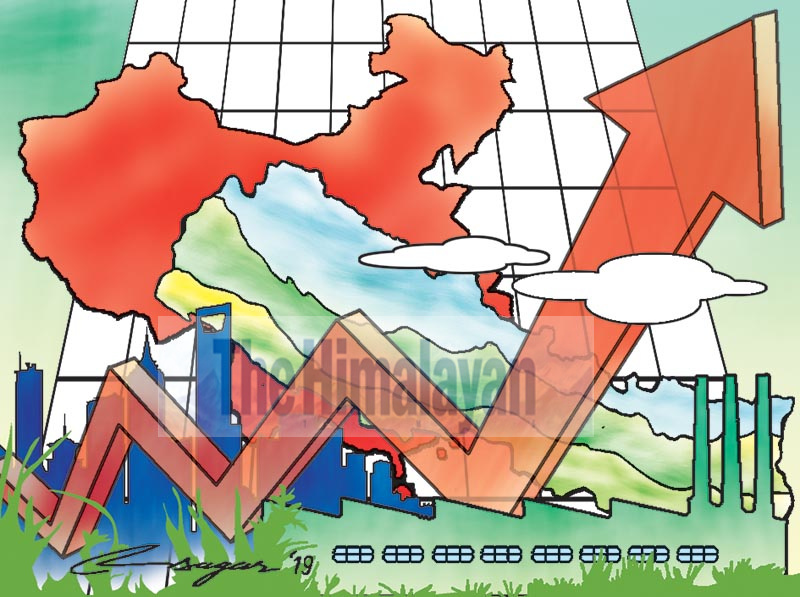Belt and Road Initiative: Nepal’s concern and commitment
Removal of non-tariff barriers — mutual accreditation arrangements, entry-exit inspection and simplified quarantine rules and regulations at the entry points, and simplification of customs procedures — can be effective tools to bridge the trade deficit
Nepal’s participation in the Belt and Road Initiative (BRI) goes beyond physical connectivity and also includes connectivity of ideas, trade, people, finance and the whole spectrum of connectivity.
On three tracks we could realise the benefit that this important initiative offers, and in the days ahead, perhaps, the government in collaboration with the private sector and with the knowledge community could come up with some idea on realising it. The main focus of the meeting between the Presidents of Nepal and China, during President Bidhya Bhandari’s visit to China this week, it has been learnt, will be on expediting the Kerung-Kathmandu Railway project.
Discussion on the pre-feasibility study of the Kerung-Kathmandu-Pokhara railway and Kerung-Kathmandu-Lumbini railway are also on the cards. Also included in the agenda is signing of the Protocol on Transit and Transportation, a landmark agreement signed by the two countries in 2016 during the first visit of Prime Minister KP Sharma Oli to Beijing. Once the protocol comes into effect, it will allow Nepali traders to use Chinese sea and land ports for third-country trade.
According to the agreement, Nepal will be able to use four Chinese seaports in Tianjin, Shenzhen, Lianyungang and Zhanjiang and three dry ports in Lanzhou, Lhasa and Shigatse.
The BRI was put forward by President Xi Jinping in 2013 in a bid to build the Silk Road and 21st century maritime Silk Road. And up to now, 80 plus countries and international organisations have signed a hundred cooperative memoranda with China under this framework.
The formality to join the BRI by Nepal is over, and now the focus should be on further cooperation under the BRI. Currently, China has developed new interests in Nepal to make Kerung the gateway to South Asia, which holds bilateral and regional importance. All the parties and people have collectively accepted and tried to be connected under the BRI.
During the tenure of Prime Minister Sushil Koirala, Nepal became a founder member of the Asian Infrastructure Investment Bank; during the tenure of Prime Minister K.P. Oli, Nepal signed the transit treaty; during the tenure of Prime Minister of Pushpa Kamal Dahal “Prachanda”, Nepal joined the One Belt One Road (OBOR) initiative; and during the tenure of PM Sher Bahadur Deuba, Nepal allocated budget for the Detailed Project Report for the railway line from China.
Due to our geographical condition, a single passage is not enough. Nepal needs more connectivity from north to south as Nepal is elongated east to west. Following the destruction by the 2015 earthquake, China shifted the trading route from Tatopani to Rasuwagadhi. Through the route envisaged, Nepal could export various products using the shortest trade and transit route, saving transshipment and transit costs. BRI is not only a bilateral agreement but the shortest route to facilitate our trade: both export and import.
Although China has become a major trading partnerl, we suffer a huge trade deficit with China. Hence, it is necessary to promote the export of Nepali products to China to bridge the gap. Removal of non-tariff barriers -- mutual accreditation arrangements, entry-exit inspection and simplified quarantine rules and regulations at the entry points, including mainland China, and simplification of customs procedures -- can be effective tools to bridge the divide.
When we talk of Nepal China relations, establishing the following norms will prove beneficial: Strengthening policy coordination and consolidating mutual trust, for which the two governments must actively carry out dialogue and communication and exchange high-level visits at all levels more frequently. Second, expanding connectivity and shared experiences for the economic development of the countries concerned.
Third, promoting uninterrupted trade though jointly built roads for win-win cooperation. In 2017, surface road trade amounted to US$ 990 million, up 11% over the previous year. In order to promote the traditional trade subsisting between China and Nepal, both the countries have pushed forward joint feasibility study of a China-Nepal Free Trade Agreement. China-Nepal cross-border economic cooperation, negotiation and signing of a Bilateral Investment Promotion and Protection Agreement (BIPPA) are some of the aspects that need immediate attention.
In November last year, Nepal participated with a pavilion in the first China International Import Export Exhibition in Shanghai. China had shown interest in welcoming more enterprises from Nepal to promote products like tea and coffee besides handicrafts. China and Nepal need to further upgrade the level of trade facilitation and improve the investment environment to enhance win-win cooperation. The potential projects for investment are the Kathmandu Valley Metro Project, East West Railway Link to India Project, a chemical fertiliser plant, Kathmandu- Kulekhani-Hetauda Tunnel and Tamakoshi III Hydro Power Project. Investment Board Nepal is also conducting feasibility study on a luxury resort in the Shey Phoksundo National Park, a ski resort in Manang, an education, health and sports city and an integrated agriculture programme.
Singh is with the Confederation of Nepalese Industries






